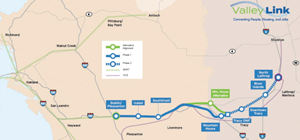News
Valley Link aims to be the nation’s first passenger rail system to operate on self-produced green H2 fuel
San Joaquin Valley Regional Rail Authority board of directors approved the final purchase agreement with the City of Tracy for 200 acres of property to be used for the Valley Link rail project. This follows the Authority’s approval in September of the project’s H2 production feasibility study.
This property provides the critical land area needed to implement a green H2 production facility that will support the Authority’s vision of sustainability for the Valley Link rail project – to be the first passenger rail system in California to run on self-produced, green H2, with a H2 fuel production facility able to support the clean energy goals of other transit and heavy truck operators. Valley Link’s goal to operate zero emission, H2 rail vehicles make it a model of environmental and economic sustainability.
“Valley Link’s self-produced, green hydrogen will reduce the cost of the overall project operations for the public and offset state and federal transit subsidies,” said Veronica Vargas, Chair of the Authority Board of Directors. “The project’s vision also supports opportunities to create and sustain new living wage jobs in both the hydrogen fuel production and related renewable energy industries. This is good for both the economy and the environment.”
The 26-mile Valley Link Rail Project Phase 1 between the Dublin/Pleasanton Bay Area Rapid Transit (BART) station in Alameda County and the Mountain House station in San Joaquin County, will connect tens of thousands of Bay Area workers now commuting daily from their homes in communities in the Northern San Joaquin Valley – some of the state’s most disadvantaged communities located in one of the most polluted air basins in the U.S.
The Authority is leading the implementation of the Valley Link rail project as a model of sustainability – one that could operate on its own created renewable energy, support transit-oriented land use development around station areas, and promote innovation in station access, while maximizing air quality, equity, health, and workforce benefits.
Director of Mountain House Community Services District, Bernice King Tingle said, “To achieve our goals for the economy, the environment, housing, transportation, and equity – we need a clean, reliable, high frequency rail alternative to I-580 that will equitably serve our residents and work force with a better quality of life and access to jobs, affordable housing, educational opportunities and health care facilities.”
To date, the state has invested in several H2 vehicle technologies and several transit agencies in California are producing their own H2 fuel. The sustainability vision of the Valley Link rail project seeks to significantly expand on this concept including the opportunity to manage risk and maximize the outcomes of green H2 production through public-private partnership with expertise from the H2 production industry.
Alameda County District 1 Supervisor, David Haubert said, “The Valley Link hydrogen production business model is intended to serve as not only a catalyst for private investment, but also for a green energy economy within the Northern California megaregion combined with workforce development to create and sustain living wage jobs."
While the feasibility study identifies the sizing of the production facility to meet Valley Link’s initial operating segment fuel needs, the Authority recognizes that there will be the opportunity to scale up a facility to ensure that both public and private investment in a green H2 hub can expand the availability, and reduce the cost, of green hydrogen to other users.
“Valley Link is well-positioned to be a model of sustainability capitalizing on innovative technology and recent public and private sector investments to operate on its self-generated renewable energy,” said Tim Sbranti, Director of Strategic Initiatives for Innovation Tri-Valley Leadership Group.


